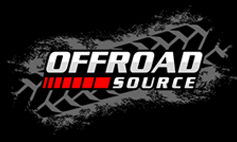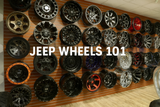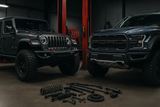Choose the right size tire for your Jeep Wrangler
Whether you plan to drive on paved streets or go off-road, we can’t stress enough the importance of your wheels and tires. Their size and form will affect your Jeep’s performance in many ways. The condition of your tires is also crucial to maintaining the integrity of your rig. The terrain you plan to navigate also needs to be taken into consideration.

Jeep Wrangler tire sizes explained
Depending on the model you drive, tires sizes can vary. However, generally speaking, when it comes to the standard factory size, the Wrangler come with 15"-17" tires.
A tire size example can be deciphered as follows: (e.g. 255/75R17)
The first set of numbers (255) refers to the tire width in millimeters.
The next set of numbers (75) is the sidewall aspect ratio, a percentage that tells us how tall and narrow the sidewall of the tire is in millimeters.
The next part of the number system describes the tire’s internal construction, in this case, ‘Radial.’ The other option is “B” for Bias Ply used on some truck types.
The last two digits in the system (17) represent the tire’s wheel diameter in inches.
Additionally, if tires are being referred to in inches, the measurement will read 33x12.50R15.
The first number (33) refers to the full-length diameter of the tire in inches, from the ground to the top of the tire.
The next number (12.50) will be the width of the tire in inches.
The last number (15) is the rim’s diameter in inches.
That being said, all models will accept upgraded or up-sized tires, thereby improving overall vehicle performance and capability. Changing the tire size can increase ground clearance, improve traction, impact fuel efficiency and overall vehicle health.
33" tires
Great for occasional off-roaders, those who drive primarily around town. Most Jeeps will need a leveling, lift kit or some type of modification to accommodate tires of this size. A lift kit will act as an aesthetic effect as well as a practical one.
35" tires
These tires require a 2.5"-3" lift kit. They’ll continue to work well on both paved roads and trails.
37" tires
Take your Jeep to the next level. This is the point where you’re looking at gear changes to compensate for power and fuel mileage lost due to larger, heavier tires. This size tire requires a 4" lift for off-road use as a 3" lift will likely be too tight. Regardless, when you get off-road, these tires will perform nicely.
38" tires
This size provides an extra inch in height and goes up to 14.50" in tire width (38x14.50R17). The 38" tires are hard to turn, and you’ll need some horsepower behind them. Again, they’re great for off-road use, but not good for commuters.
40" tires
These tires can’t be beat for off-road use. The extra height turns obstacles into simple non-events. When considering clearance issues, you’ll need at least a 6" lift unless you do some major body modifications to make them fit properly.
How long will Jeep tires last?
Much like the impact of tire size, the condition of your tire will impact its performance. Stock tires with minimal wear and tear will get anywhere from 50-60k miles. However, those numbers can change quickly if you do a significant amount of off-roading. On the other hand, if you’re mainly a freeway driver, your tires will last longer.
Investing in quality tires isn’t cheap, but in the long run, repair or replacement is far more expensive. You may need to replace your tires because of issues with alignment, suspension, tire balance, or chunking/chipping that comes with off-road use.
Where will you drive your Jeep?
Jeeps generally come standard with all-terrain or mud-terrain tires. Whether you choose all terrain or mud terrain tires depends on how and where you’ll be driving.
All-terrain tires
These types of tires are designed for on- and off-road use. Most offer a mileage warranty between 40-60K miles and some have a 3-Peak Snow Flake rating for winter driving.
Mud terrain tires
With aggressive tread patterns and larger lugs, these tires offer extraordinary gripping power in all kinds of off-highway terrain, especially wet snow and mud. They are also extremely durable, with super-tough sidewalls to absorb the impact of rocks and other off-road hazards.
Pro Tip: PSI (pounds per inch)
Most serious off-road enthusiasts “air down,” or reduce the air pressure in their tires before they hit the trails. Doing this increases the amount of tire surface that touches the road improving traction. Just remember to air back up before you drive on pavement. Driving at highway speeds on low tires is bad for your tires and can be dangerous.
Knowing how and where you plan to use your tires as well as getting familiar with various tire sizes will narrow down your options. However, you can rest assured there’s a solution that’s right for you and your Jeep.
Live Chat with us Below if you have any questions on picking the right size tires for your wrangler.
Recent Posts
-
Jeep Wheels 101 | Everything You Need to Know
Jeep Wheels 101 | Everything You Need to Know Upgrading your Jeep wheels is one of the most exciting …Jul 7th 2025 -
7 Ways to Customize Your Off-Road Vehicle for Optimal Performance
Off-road enthusiasts know that having a reliable, high-performing vehicle is key to conquering chal …Apr 4th 2025 -
The Ultimate Guide to Choosing the Right Lift Kit for Your Off-Road Truck
When it comes to off-roading, having the right lift kit for your truck is essential for performance, …Mar 28th 2025




